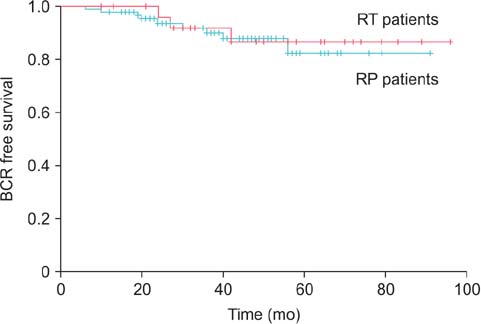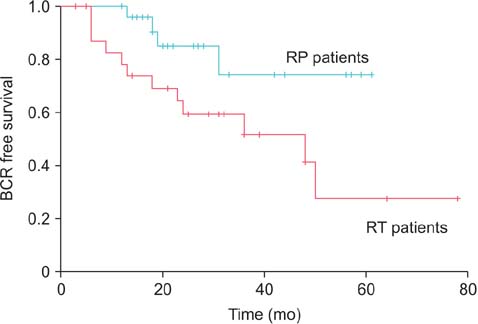Korean J Urol.
2015 Oct;56(10):703-709. 10.4111/kju.2015.56.10.703.
Comparison of biochemical recurrence in prostate cancer patients treated with radical prostatectomy or radiotherapy
- Affiliations
-
- 1Department of Urology, Kyung Hee University School of Medicine, Seoul, Korea. hyubv@naver.com
- KMID: 2344113
- DOI: http://doi.org/10.4111/kju.2015.56.10.703
Abstract
- PURPOSE
We evaluated the biochemical recurrence (BCR) of prostate cancer patients treated by radical prostatectomy (RP) or radiotherapy (RT).
MATERIALS AND METHODS
Patients who underwent RP or RT as primary definitive treatment from 2007 were enrolled for this study. They were divided into two groups; the low-intermediate risk group and the high risk group according to the National Comprehensive Cancer Network guidelines. We compared differences such as age, prostate specific antigen, Gleason score, follow-up duration, clinical T staging, and BCR. Their BCR-free survival rates were analyzed.
RESULTS
A total of 165 patients were enrolled. There were 115 patients in the low-intermediate risk. Among them, 88 received RP and 27 underwent RT. BCR occurred in 9 of the RP patients (10.2%) and 3 of the RT patients (11.1%). For the high risk group, 50 patients were included. RP was performed in 25 patients and RT in 25 patients. BCR was observed in 4 of the RP patients (16%) and 12 of the RT patients (48%). There were no differences in BCR-free survival for the low-intermediate group (p=0.765). For the high risk group, the RP group had a higher BCR free survival rate (p=0.032).
CONCLUSIONS
No difference of BCR and BCR-free survival was seen in the low-intermediate risk group but lower BCR and better BCR-free survival were observed for patients that received RP in the high risk group. RP should be a more strongly considered option when deciding the treatment method for selected high risk patients.
Keyword
MeSH Terms
Figure
Reference
-
1. Siegel R, Ma J, Zou Z, Jemal A. Cancer statistics, 2014. CA Cancer J Clin. 2014; 64:9–29.2. Marugame T, Katanoda K. International comparisons of cumulative risk of breast and prostate cancer, from cancer incidence in five continents Vol. VIII. Jpn J Clin Oncol. 2006; 36:399–400.3. Lee J, Demissie K, Lu SE, Rhoads GG. Cancer incidence among Korean-American immigrants in the United States and native Koreans in South Korea. Cancer Control. 2007; 14:78–85.4. Schroder FH, Hugosson J, Roobol MJ, Tammela TL, Ciatto S, Nelen V, et al. Screening and prostate-cancer mortality in a randomized European study. N Engl J Med. 2009; 360:1320–1328.5. Aizer AA, Paly JJ, Zietman AL, Nguyen PL, Beard CJ, Rao SK, et al. Multidisciplinary care and pursuit of active surveillance in low-risk prostate cancer. J Clin Oncol. 2012; 30:3071–3076.6. Heidenreich A, Bastian PJ, Bellmunt J, Bolla M, Joniau S, van der Kwast T, et al. EAU guidelines on prostate cancer. part 1:screening, diagnosis, and local treatment with curative intentupdate 2013. Eur Urol. 2014; 65:124–137.7. Fowler FJ Jr, McNaughton Collins M, Albertsen PC, Zietman A, Elliott DB, Barry MJ. Comparison of recommendations by urologists and radiation oncologists for treatment of clinically localized prostate cancer. JAMA. 2000; 283:3217–3222.8. D'Amico AV, Whittington R, Malkowicz SB, Cote K, Loffredo M, Schultz D, et al. Biochemical outcome after radical prostatectomy or external beam radiation therapy for patients with clinically localized prostate carcinoma in the prostate specific antigen era. Cancer. 2002; 95:281–286.9. Martinez AA, Gonzalez JA, Chung AK, Kestin LL, Balasubramaniam M, Diokno AC, et al. A comparison of external beam radiation therapy versus radical prostatectomy for patients with low risk prostate carcinoma diagnosed, staged, and treated at a single institution. Cancer. 2000; 88:425–432.10. Lee JY, Cho KS, Kwon JK, Jeh SU, Kang HW, Diaz RR, et al. A competing risk analysis of cancer-specific mortality of initial treatment with radical prostatectomy versus radiation therapy in clinically localized high-risk prostate cancer. Ann Surg Oncol. 2014; 21:4026–4033.11. Mohler JL, Armstrong AJ, Bahnson RR, Boston B, Busby JE, D'Amico AV, et al. Prostate cancer, Version 3.2012: featured updates to the NCCN guidelines. J Natl Compr Canc Netw. 2012; 10:1081–1087.12. Sim HG, Telesca D, Culp SH, Ellis WJ, Lange PH, True LD, et al. Tertiary Gleason pattern 5 in Gleason 7 prostate cancer predicts pathological stage and biochemical recurrence. J Urol. 2008; 179:1775–1779.13. Roach M 3rd, Hanks G, Thames H Jr, Schellhammer P, Shipley WU, Sokol GH, et al. Defining biochemical failure following radiotherapy with or without hormonal therapy in men with clinically localized prostate cancer: recommendations of the RTOG-ASTRO Phoenix Consensus Conference. Int J Radiat Oncol Biol Phys. 2006; 65:965–974.14. Potters L, Klein EA, Kattan MW, Reddy CA, Ciezki JP, Reuther AM, et al. Monotherapy for stage T1-T2 prostate cancer: radical prostatectomy, external beam radiotherapy, or permanent seed implantation. Radiother Oncol. 2004; 71:29–33.15. Grimm P, Billiet I, Bostwick D, Dicker AP, Frank S, Immerzeel J, et al. Comparative analysis of prostate-specific antigen free survival outcomes for patients with low, intermediate and high risk prostate cancer treatment by radical therapy. Results from the Prostate Cancer Results Study Group. BJU Int. 2012; 109:Suppl 1. 22–29.16. Petrelli F, Vavassori I, Coinu A, Borgonovo K, Sarti E, Barni S. Radical prostatectomy or radiotherapy in high-risk prostate cancer: a systematic review and metaanalysis. Clin Genitourin Cancer. 2014; 12:215–224.17. Borza T, Kibel AS. Local treatment of high risk prostate cancer: Role of surgery and radiation therapy. Cancer. 2014; 120:1608–1610.18. Klein EA, Ciezki J, Kupelian PA, Mahadevan A. Outcomes for intermediate risk prostate cancer: are there advantages for surgery, external radiation, or brachytherapy? Urol Oncol. 2009; 27:67–71.19. Schreiber D, Rineer J, Weiss JP, Safdieh J, Weiner J, Rotman M, et al. Clinical and biochemical outcomes of men undergoing radical prostatectomy or radiation therapy for localized prostate cancer. Radiat Oncol J. 2015; 33:21–28.20. Kang HW, Lee JY, Kwon JK, Jeh SU, Jung HD, Choi YD. Current status of radical prostatectomy for high-risk prostate cancer. Korean J Urol. 2014; 55:629–635.21. Meng MV, Elkin EP, Latini DM, Duchane J, Carroll PR. Treatment of patients with high risk localized prostate cancer: results from cancer of the prostate strategic urological research endeavor (CaPSURE). J Urol. 2005; 173:1557–1561.22. Everaerts W, Van Rij S, Reeves F, Costello A. Radical treatment of localised prostate cancer in the elderly. BJU Int. 2015; 03. 23. [Epub]. DOI: 10.1111/bju.13128.23. Spahn M, Joniau S, Gontero P, Fieuws S, Marchioro G, Tombal B, et al. Outcome predictors of radical prostatectomy in patients with prostate-specific antigen greater than 20 ng/ml: a European multi-institutional study of 712 patients. Eur Urol. 2010; 58:1–7.
- Full Text Links
- Actions
-
Cited
- CITED
-
- Close
- Share
- Similar articles
-
- Hospital readmissions for patients with prostate cancer are higher after radiotherapy than after prostatectomy
- How can we best manage biochemical failure after radical prostatectomy?
- Salvage Radiotherapy for Patients with PSA Relapse Following Radical Prostatectomy: Issues and Challenges
- Radical Prostatectomy
- A Case of No Residual Cancer in Radical Prostatectomy Specimens Despite Biopsy-proven Prostate Cancer



